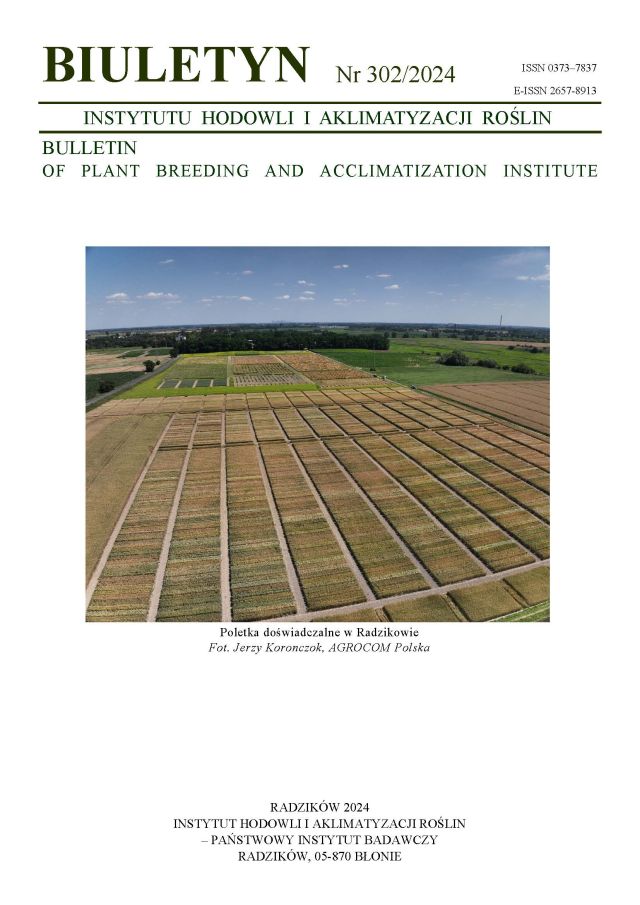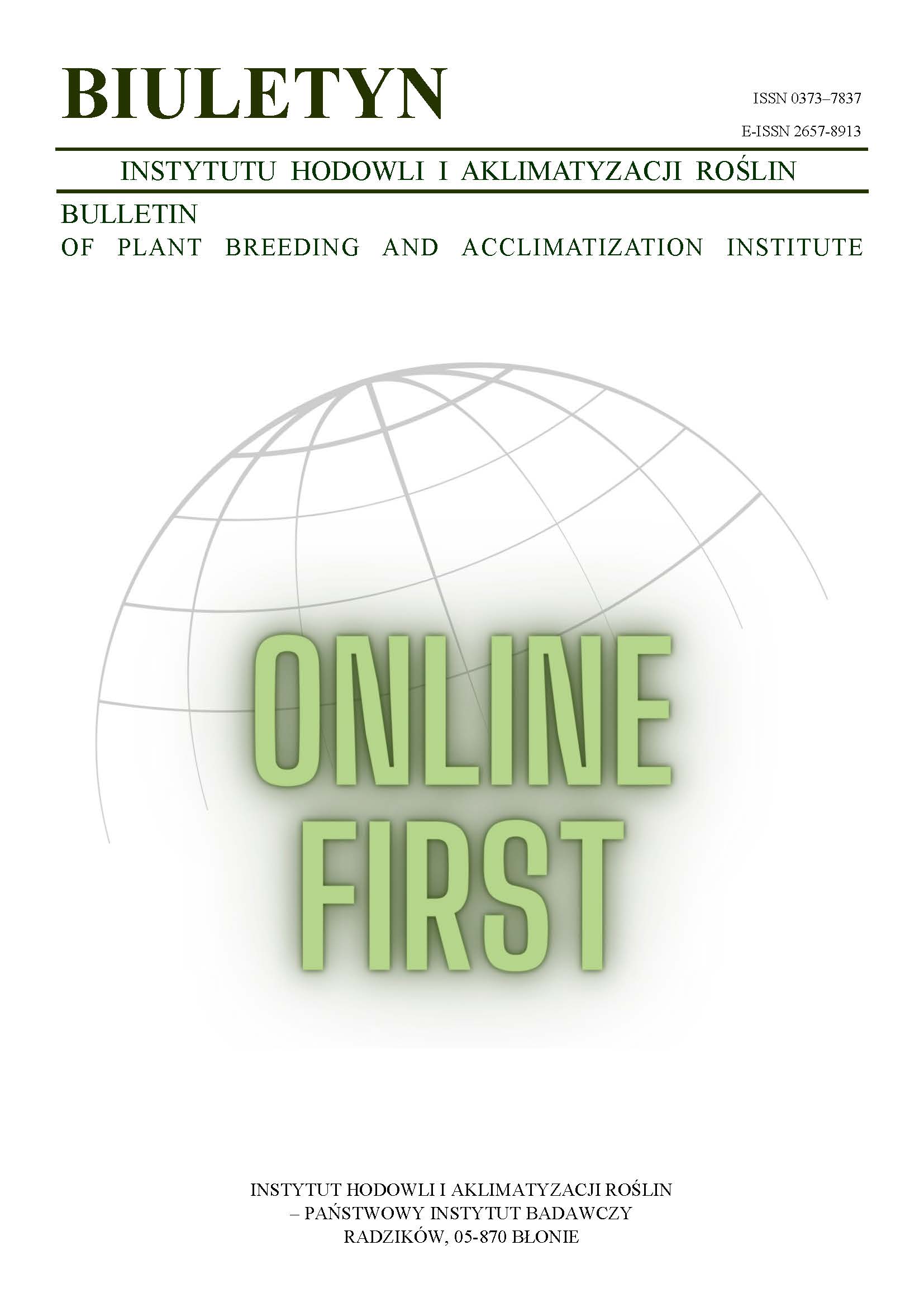IBA and Ekolist in white lupin seed production
Magdalena Borowska
biuro.dziekana.wrib@pbs.edu.plAkademia Techniczno-Rolnicza w Bydgoszczy (Poland)
Janusz Prusiński
Akademia Techniczno-Rolnicza w Bydgoszczy (Poland)
Abstract
The aim of the study was to evaluate the effects of different doses and dates of application of IBA (indolilo-3-butyric acid) and Ekolist (multi-ingredient fertilizer with fungicide properties) on white lupin seed yielding. The strict two-factor field experiment in split-plot design with a control object was carried out in 2001–2003 at the Mochełek Experiment Station. The plants of traditional white lupin cultivar Butan were sprayed with IBA at doses of 20, 40 and 60 mg/dm3 at the beginning of flowering, and with Ekolist (3, 6 i 9 dm3/ha) at the end of flowering. IBA and Ekolist significantly affected white lupin seed yield; the highest seed yield increase was obtained following plant spraying with 60 mg/dm3 of IBA and 9 dm3/ha of Ekolist. Auxine applied at the beginning of flowering, in combination with Ekolist used at the end of flowering, did not enhance seed yield significantly. There were no significant differences in the effect of IBA and Ekolist on white lupin seed yield and yield components. As compared to the control, both a number of pods and seeds and seed weight per main stem were affected significantly, especially at medium and high doses of the substances tested. The number and weight of seeds developed on branches of plants sprayed with IBA and Ekolist were also higher compared to the control. The best effects were obtained with a high dose of Ekolist and high doses of IBA and Ekolist applied together. No significant effect of the substances tested on weight of 1000 lupin seeds was found.
Keywords:
Ekolist, indolilo-3-butyric acid (IBA), seed yield, yields components, white lupinReferences
Aufhammer W., Nalborczyk E., Geyer B., Götz J., Mack C., Paluch S. 1989. Interactions between and within inflorescence in relation to the storage capacity of field beans (Vicia faba). J. Agric. Sci. 112: 419 — 424.
DOI: https://doi.org/10.1017/S0021859600085877
Google Scholar
Bangerth F. 1989. Dominance among fruits/sinks and the search for correlative signal. Physiol. Plant. 76: 608 — 614.
DOI: https://doi.org/10.1111/j.1399-3054.1989.tb05487.x
Google Scholar
Byszewski W., Sadowska A. 1976. Wpływ nawożenia dolistnego Wuxalem na plon nasion łubinu żółtego (Lupinus luteus L.). Zesz. Probl. Post. Nauk Rol.: 45 — 59.
Google Scholar
Heath M. C., Pilbeam C. J., McKenzie B. A, Hebblethwaite P. D., Muehlbauer F. J., Kaiser W. J. 1994. Plant architecture, competitive ability and crop productivity in food legumes with particular emphasis on pea (Pisum sativum L.) and faba bean (Vicia faba L.). Expanding the production and use of cool season food legumes. Proc. 2nd Inter. Food legume research conference on pea, lentil, faba bean, chickpea, and grasspea. Cairo, Egypt: 771 — 790.
DOI: https://doi.org/10.1007/978-94-011-0798-3_47
Google Scholar
Klasa A., Nowak G. A., Wierzbowska J., Gotkiewicz M. 1996. Wpływ niektórych regulatorów wzrostu i ich mieszanin na plonowanie i skład chemiczny bobiku (Vicia faba var. minor Harz). Cz. I. Wpływ inhibitora transportu auksyny (TIBA) i syntetycznych auksyn (IBA i NAA) na plonowanie oraz gospodarkę azotową i fosforową. Biul. IHAR 197: 235 — 245.
Google Scholar
Klasa A., Nowak G. A., Wierzbowska M., Gotkiewicz M. 1997. Badania nad stosowaniem regulatorów wzrostu w uprawie bobiku (Vicia faba ssp. minor Harz). Zesz. Probl. Post. Nauk Rol., 447: 199 — 205.
Google Scholar
Kotecki A. 1990. Wpływ temperatury i opadów na rozwój i plonowanie łubinu żółtego odmiany Topaz. Zesz. Nauk. AR Wrocław, Rolnictwo 199: 97 — 107.
Google Scholar
Koter M., Czapla J., Nowak G., Nowak J. 1983. Badania możliwości stosowania regulatorów wzrostu w produkcji rolniczej. I. Działanie GA3, IAA i kinetyny na wzrost i rozwój roślin fasoli, kukurydzy i lnu. Zesz. Nauk. ART Olsztyn, Rolnictwo 36: 17 — 27.
Google Scholar
Księżak J., Podleśny J., Lenartowicz W. 1993. Dolistne dokarmianie mikroelementami roślin strączkowych. Fragm. Agron. 4: 195 — 196.
Google Scholar
Księżak J., Podleśny J., Lenartowicz W. 1994. Wpływ dolistnego dokarmiania nawozami dolistnymi na plonowanie łubinu białego. Mat. konf. nauk. „Łubin — Białko — Ekologia” PTŁ Poznań: 338 — 341.
Google Scholar
Kulig B., Ziółek W. 1996. Produktywność bobiku w warunkach nawożenia wieloskładnikowymi nawozami mikroelementowymi. Zesz. Probl. Post. Nauk Rol. 434: 172 — 177.
Google Scholar
Nalborczyk E. 1993. Biologiczne uwarunkowania produktywności roślin strączkowych. Fragm. Agron. 4: 147 — 150.
Google Scholar
Nowak G. A., Klasa A., Wierzbowska J., Gotkiewicz M. 1997. Plonowanie oraz zawartość makroelementów w warunkach stosowania retardantów wzrostu i fitohormonów. Cz. 1. Plonowanie roślin. Biul. IHAR 201: 289 — 294.
Google Scholar
Pawłow A. N, Duchanin A. A., Sawienkow Ł. M. 1981. Pricziny opadienja zawiaziej u żiełtogo ljupina. Sielskochozajstviennaja biologija, XVI (6): 827 — 831.
Google Scholar
Podleśny J. 1996. Wpływ kilku biostymulatorów na plonowanie i termin dojrzewania nasion łubinu białego. Mat. konf. nauk. Łubin: kierunki badań i perspektywy użytkowe. PTŁ Poznań: 53 — 59.
Google Scholar
Prusiński J., Borowska M. 2001. Impact of selected growth regulators and Ekolist on yellow lupin seed yield (Lupinus luteus L.) EJPAU, www.ejpau.media.pl, Agronomy 4: 1 — 16.
Google Scholar
Prusiński J. 2002. Impact of foliar plant fertilisation and chemical control on yielding of traditional and self-completing white lupin (Lupinus albus L.) cultivars. Acta Sci. Pol., Agricultura 1 (1): 37 — 47.
Google Scholar
Prusiński J. 2005. Traditional and self-completing white lupin (Lupinus albus L.) cultivars yielding depending on foliar plant fertilization and chemical protection. EJPAU 8 (3) 41.
Google Scholar
Prusiński J., Borowska M. 2002. Potencjał biologiczny roślin strączkowych i jego wykorzystanie. Cz. I. Zastosowanie regulatorów wzrostu w uprawie roślin strączkowych. Hod. Rośl. Nasien. 2: 33 — 38.
Google Scholar
Prusiński J., Borowska M. 2003. Potencjał biologiczny roślin strączkowych i jego wykorzystanie. Cz. II. Dolistne dokarmianie roślin strączkowych. Hod. Rośl. Nasien. 1: 8 — 13.
Google Scholar
Ruszkowska M. 1991. Rola mikroelementów w biologicznym wiązaniu N2. Mat. VI Symp. Mikroelementy w rolnictwie. AR Wrocław: 5 — 13.
Google Scholar
Szukała J. 1994. Wpływ czynników agrotechnicznych na plon, skład chemiczny i wartość siewną nasion łubinów, ze szczególnym uwzględnieniem łubinu białego. Rocz. AR w Poznaniu, Rozpr. Nauk. 245.
Google Scholar
Authors
Magdalena Borowskabiuro.dziekana.wrib@pbs.edu.pl
Akademia Techniczno-Rolnicza w Bydgoszczy Poland
Authors
Janusz PrusińskiAkademia Techniczno-Rolnicza w Bydgoszczy Poland
Statistics
Abstract views: 56PDF downloads: 27
License
Copyright (c) 2005 Magdalena Borowska, Janusz Prusiński

This work is licensed under a Creative Commons Attribution-ShareAlike 4.0 International License.
Upon submitting the article, the Authors grant the Publisher a non-exclusive and free license to use the article for an indefinite period of time throughout the world in the following fields of use:
- Production and reproduction of copies of the article using a specific technique, including printing and digital technology.
- Placing on the market, lending or renting the original or copies of the article.
- Public performance, exhibition, display, reproduction, broadcasting and re-broadcasting, as well as making the article publicly available in such a way that everyone can access it at a place and time of their choice.
- Including the article in a collective work.
- Uploading an article in electronic form to electronic platforms or otherwise introducing an article in electronic form to the Internet or other network.
- Dissemination of the article in electronic form on the Internet or other network, in collective work as well as independently.
- Making the article available in an electronic version in such a way that everyone can access it at a place and time of their choice, in particular via the Internet.
Authors by sending a request for publication:
- They consent to the publication of the article in the journal,
- They agree to give the publication a DOI (Digital Object Identifier),
- They undertake to comply with the publishing house's code of ethics in accordance with the guidelines of the Committee on Publication Ethics (COPE), (http://ihar.edu.pl/biblioteka_i_wydawnictwa.php),
- They consent to the articles being made available in electronic form under the CC BY-SA 4.0 license, in open access,
- They agree to send article metadata to commercial and non-commercial journal indexing databases.
Most read articles by the same author(s)
- Janusz Prusiński, Magdalena Borowska, Ewa Kaszkowiak, Chosen productivity indexes of faba bean fertilized with increasing N doses , Bulletin of Plant Breeding and Acclimatization Institute: No. 248 (2008): Regular issue
- Janusz Prusiński, Tomasz Olach, Snap bean (Phaseolus vulgaris L.) yielding affected by intensity of cultivation technology. Part II. Agricultural and economic evaluation , Bulletin of Plant Breeding and Acclimatization Institute: No. 243 (2007): Regular issue
- Janusz Prusiński, Tomasz Olach, Snap bean (Phaseolus vulgaris L.) yielding affected by intensity of cultivation technology. Part I. Pod yielding and quality , Bulletin of Plant Breeding and Acclimatization Institute: No. 243 (2007): Regular issue














